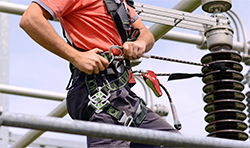Working at height is one of the biggest causes of injury (HSE) and fatality in the workplace. On construction sites and in warehouses, risk of falling means that serious personal injury is a possibility. Although it’s not pleasant to think about, it’s important that workers and managers take a proactive approach to correctly using safety harnesses. The Health and Safety Executive has produced a guide to the selection and use of fall prevention and arrest equipment (HSE).
Safety harnesses should be worn whilst carrying out any task where there is a risk of falling. It goes without saying that any workplace should have a full and current risk assessment associated with it. Before carrying out a task that requires working at height, it’s important to fully assess the risks. Ask how long will the worker be exposed to the risk? At what height will they be working? If working at height can be avoided, it should be.
What are the fall restraint systems?
A fall restraint system prevents workers from falling by stopping them from reaching the area where there is a risk of falling. Usually, workers will clip their harness onto a lanyard, with the other side attached to a railing that runs the length of the area where the fall risk is. The lanyard attached to the harness is not long enough for the person to reach the fall risk area.
These restraint harnesses are usually used at low heights and on walkways. As they are easy to use, they’re a simple piece of equipment to implement into a risky workplace. Whilst fall restraint harnesses are effective, they don’t offer the same protection as a full-body harness, and in some cases, the harness could risk spinal injuries.
What are the fall arrest systems?
Fall arrest systems usually consist of a full-body harness with straps over the shoulders, connected to a safety belt around the waist. Ropes or lanyards attach to the harness with a carabiner, and the carabiner will be attached to an anchor point somewhere.
This distributes the force of a fall when used, protecting the body against both the dangers of falling and injury from fall protection equipment.
These fall arrest harnesses are usually worn instead of fall restraint systems at more dangerous heights – such as when working on a roof or a fragile surface. They are very effective when used properly and can prevent serious injuries from occurring.
Checking your fall protection harness
Harnesses should be fully inspected if they were worn during a fall, have been worn regularly for a period of time, or haven’t been worn in a long time. Before each use, you should inspect the harness for signs of wear and tear. Check the buckles or fasteners and make sure the equipment is in good working order. Look for signs of wear in the webbing and any deformity in the solid parts of the harness.
It is important to make sure that your anchor point is secure and stable. It’s no good having a good quality harness if it’s not attached to a suitable anchor point. If you need a degree of mobility, when climbing or moving between floors, for example, a fixed anchor point may not be suitable. If you are using a flexible anchor point you might need to consider using a retractable lifeline so that you don’t fall too far. Remember that excess slack can be dangerous.
With the risks of falls in the workplace being so high, you can never be too careful and should always wear a harness where possible. It can prevent serious injury and death, even if you’re working at relatively low heights which you don’t consider to be excessively risky.





Leave a comment